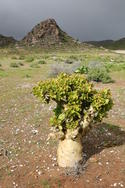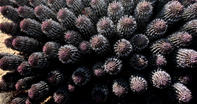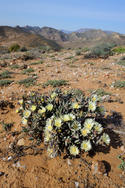Leafy Bladders

There are many species of vygies in Namaqualand and the Richtersveld, contributing a great deal to the region’s biodiversity.
Despite their ubiquity, they only start to appear on the fossil record a relatively recent 12000 years ago.
However, this may be because desert environments are not conducive to the creation of plant fossils.
Vygies are succulents, with special bladder cells contained in their leaves.
Their flowers are also very bright, even luminous, with lots of petals. This eye-catching ‘inflorescence’ is designed to attract the attention of pollinating insects.
Mesembs are sometimes called ‘midday flowers’ because they usually open their flowers when the sun is at its brightest.
Their leaves are not palatable and rarely eaten by grazing animals or insects.
The Rosyntjieberg Mountain in the Richtersveld National Park contains a large number of vygie species.
An Appetite for Candles and Butter

Botterboom (Tylecodon paniculatus): Translated as ‘butter tree’, this is a chubby dwarf succulent with a thick stem. It is found in many parts of the Richtersveld Community Conservancy and in the Richtersveld National Park.
Ghaap (Hoodia Gordonii): Hoodia has been used as an appetite suppressant by Bushmen and Khoikhoi people for hundreds of years. The plant’s active ingredient has been isolated by the South African Council for Scientific and Industrial Research (CSIR).
This is now licensed to pharmaceutical companies who market it as a diet pill. In 2002, CSIR concluded negotiations with Bushman representatives and now pays a royalty to San Hoodia Benefit Sharing Trust for the indigenous knowledge that led to the development of the pill.
The money goes towards the upliftment of San communities across southern Africa.
Bushman’s Candle (Sarcocaulon patersonii). This plant has a thick, waxy bark to protect it from sand storms. The bark burns quite easily, albeit with a lot of smoke, giving the plant its common name.
Symbol of the Richtersveld

The amazing Halfmens (Pachydodium namaquanum) is a much photographed pin-up plant that has come to symbolise the Richtersveld. A large stem succulent, or tree succulent, the enigmatic and endangered halfmens (meaning half human) is a cactus-like plant with a sprout of leaves on top of its ‘head’ and couple of curved appendages that bend out from the central stem.
The ‘head’ of the plant always leans towards the north and this inclination is explained by an ancient legend. Many years ago, there was a warlike tribe who lived in the north. One day, during a battle, they were driven from their lands and chased over the Orange River, into the Richtersveld.
Here, God turned them into strange creatures; half-human, half-plant. With their feet literally rooted to the spot, the tribe was stranded and, to this day, they stand in the Richtersveld, always looking north to gaze longingly at their former home. It’s a nice story, but the botanical reality is far more prosaic.
The waxy rosette of leaves on the plant’s ‘head’ is actually its energy source, absorbing water and the sun’s energy. Thus, they incline to the north in order to harness the sun more effectively. Growing up to 5 m tall, the halfmens develops mainly in the winter months, when it sprouts nectar-rich, trumpet-shaped flowers.
In summer, it drops its leaves and relies on a thick, spiny covering to protect it from the burning sun. The spines also protect it from grazing animals and aid in the collection of rainwater and moisture from the malmokkies. The halfmens is endemic to the Richtersveld and it is quite rare.
I must confess that during my visit, I totally failed to spot one. Nevertheless, it is one of the most famous plants of the region. Its closest relative (P. lamerei) is found only in Madagascar.
By David Fleminger